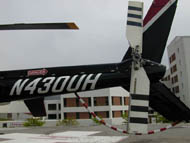Hospitals eTool
Heliport » Equipment Hazards
Hazards

The tail rotor and the main rotor system (helicopter blades) can injure or kill an unaware or uneducated staff member. Hats, loose clothing, gloves, etc., can be sucked into the engine air intake fans and cause the helicopter to malfunction and potentially crash.
Recognized Controls and Work Practices
- Limit access in this area to workers trained in helicopter equipment hazards and whose duties require presence in the area. [See 29 CFR 1910.183(o)].
- Establish safe work practices such as:
- Do not administer CPR to patients on transport carts while the carts are under the helicopter blade. This may elevate the height of the worker to the extent that the worker could be hit by the helicopter blades.
- Properly secure all items such as loose clothing, hats, gloves, and scarves while in the helicopter area. [See 29 CFR 1910.183(e)(2), (f)].
- Avoid the tail rotor area and helicopter blade area.
Additional Information
- Helicopters, materials handling and storage 29 CFR 1910.183. OSHA Standard.
- Accreditation of airborne medical transport programs is provided by the Commission on Accreditation of Medical Transport Systems (CAMTS).
- The Federal Aviation Administration (FAA) governs flight safety guidelines.
- Helicopter Air Ambulance, Commercial Helicopter, and Part 91 Helicopter Operations; Final Rule 14 CFR Parts 91, 120 and 135. Federal Aviation Administration (FAA).
- Hospital Helipads: Safety, Regulatory and Liability Issues Hospitals Must Know and Consider. National EMS Pilots Association (NEMSPA).

